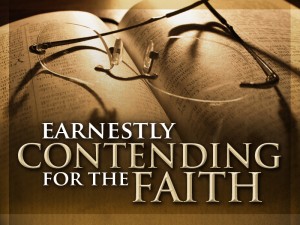The Lord’s supper is one of the most important aspects of Christian worship and an expectation with significant implications concerning His kingdom on earth. The Lord’s supper is also called ‘Communion’ in churches of Christ all over the world. In the denominational world, it is called ‘the Christian Passover’, ‘Holy Eucharist’ or in the Latin church (Catholic) ‘Mass’. The accounts of this ordinance are found in Mt. 26:26-29, Mk. 14:22-25, Lk. 22:19; 22:20, and 1Co. 11:24-26. The only gospel account that does not include the Lord’s supper is the book of John. It was designed to commemorate the sacrifice of Christ (in remembrance of Him) and an opportunity of personal reflection against that fact. It is to signify the inadequacy of self and strengthen the dedication a believer has in Jesus’ sacrifice for sins. It is a memorial. The early church practiced Communion (as it will be called here forward) on the first day of the week when Christians came together for worship. It is part of the worship service that included other functions such as singing, prayer, a monetary collection, and a message as delivered by an authorized speaker.
This paper will attempt to answer the following questions: Why can’t the Lord’s supper be taken on any day of the week or at intervals other than the first day of every week, and what is the relationship between the Lord’s supper and the Jewish Passover feast? Before answering these questions, let us look at what others have to say about this sacred act of contrition.
For most Christian-affiliated organizations, the purpose of communion is not in dispute because the scriptures are clear, that is, to remember the sacrifice that Jesus made (Lk. 22:19). What is in question are what it represents when doing it and the impact to our souls. There are three prevailing views of interest in this study: The Symbolic, Consubstantiation, and Transubstantiation perspectives (Zondervan). The overall majority of evangelical (protestant) churches such as churches of Christ, Baptists, Presbyterians, and other independent churches subscribe to the symbolic representation of communion. This view states that the bread and the cup (fruit of the vine or wine) are symbolic representations of the body and blood of Jesus. This is the most natural view in context with scripture. This perspective was first proposed during the early reformation by Ulrich Zwingli (Wikipedia), a prominent 16th century protestant reformer. Zwingli viewed Communion as a simple memorial. John Calvin a contemporary of Zwingli took it further in suggesting that we receive “spiritual nourishment from the Holy Spirit which increases our faith. (Calvin)” He suggested that “we are actually communing with the crucified Christ” (ibid).
The Consubstantiation view is largely held only by some Lutheran affiliated churches or those churches that follow the doctrines of Martin Luther. Luther suggested that while the bread and cup do not transform into the literal body and blood of Christ, His body and blood are “present in, with, and under” the elements. He used an analogy of a hot iron in that the “heat” in the iron is present just as Christ is “present” in the elements of communion.
Transubstantiation is a view held mainly by the Catholic church and some orthodox and Anglican religions. Transubstantiation suggests that the two elements literally change into the physical body and blood of Christ after a priest consecrates them. This view is taken so seriously by the Catholic church that it was proclaimed at the Council of Trent (1545-1563) that if anyone did not believe that the elements turned into the actual body and blood of Jesus, they were “anathema” (meaning accursed). It is also believed that through the Eucharist, the benefits of Christ’s death on the cross are being given over and over for the payment of each person’s sins. The Catholic Catechism also states that the Eucharist can be taken to help those who have died (#1371, #1689), and can preserve people from sin (#1393, #1395).
A reasonable person using only the inspired words in the Holy Bible can confidently conclude that of these three views, the first (Symbolic) is the most clear and exegetically sound.
The NT does not provide a specific command to take communion on the first day of the week. The precise frequency is never actually mentioned but if we are to follow the apostle’s teachings (Acts 2:42) we can get an idea of the pattern from the early church. Communion is taken on the first day of the week according to all references of it in the Pauline letters and the book of Acts (2:42 & 20:7 for example). “Upon the first day of the week…” which is specific and corresponds with other passages that this was a special day (1Co. 16:2). In some translations, it includes the proper language of “the first day of (every) week”. What was called σάββατον (sabbaton), the Lord’s day, in which they commemorated the resurrection of our Lord; and which, among all Christians, afterwards took the place of the Jewish Sabbath. Some have confused the “breaking of bread” as always being in reference to a meal but a comparison of Acts 2:42 vs 2:46 contextually shows the difference. There is no passage that suggests communion was to be done on any holiday (Jewish or pagan) or on any day of the week other than the first day. Since Jesus was raised on the first day of the week and the purpose of the memorial was to commemorate that fact, combined with scriptural references of the early church (1Co. 11:23ff), a person can inductively conclude that it was to be done on the first day of the week. In order to change this practical understanding, one must reach far and wide in their logic or rely on what the Bible doesn’t say in order to find a remotely plausible argument (which is no argument at all). Nevertheless, humanism has prompted people to treat communion like it is something to be done whenever one feels like it or in some arbitrary way. In some churches, communion is done only on specific national holidays such as Christmas and Easter (both of which are pagan in origin). Some just do it once a month, quarterly or semi-annually. Others such as the Amish (an Anabaptist sect) do it twice a year, once for spring and again in the fall with the harvest. None of these patterns are scripturally supportable.
The last question to be addressed is the relationship between the Lord’s supper and the Passover. The Passover was created during the time when Israel was still in bondage to Egypt. It represents the exodus of the Children of Israel from Egyptian slavery when God “passed over” the houses of the Israelites during the last of the ten plagues. The Passover is first mentioned in Exo. 12 when the LORD gave the edict to Aaron and Moses to be observed by Israel. It was to begin on the first month, on the fourteenth day of the month at twilight and last for 7-days (Exo. 12:15, 19; Lev. 23:5-8). The frequency of the Passover feast was once per year. Communion is to be observed “on the first day of every week”. The purpose of the Passover was to offer sacrifices for sins and to remind Israel of God’s sacrifice to bring them out of Egypt. Passover was to be observed by the Jews only and was valid under the Law of Moses. Communion is to be observed by all Christians under the law of Christ or the new covenant. No Gentile or ‘foreigner’ could partake of the Passover lamb unless he was circumcised. Each household had to contribute an unblemished male lamb (or goat) for sacrifice every year. Since Christ, He became our Passover lamb once and for all time fulfilling the old law and ushering in a new one where animal sacrifices are no longer needed. The Passover feast was a meal whereas Communion is memoriam. Curt Landry, a messianic Jewish minister with a mix of Pentacostal and Jewish charismatics suggests that Communion was a regular meal just like the Passover feast when he says, “We must remember that the Lord’s Supper was a Passover meal!” and “When we fail to remember this key component of our heritage, we miss out on the blessings of understanding true spiritual freedom!” (Landry). The last sentence speaks volumes as to character and motive and is the kind of statement that attempts to guilt a person into believing as he does. Based on the contents of his website, he uses his Jewish heritage as a badge of authority in his ministry. If he is sincere towards Christ regarding the Lord’s supper, Mr. Landry would do well to study what the Apostle Paul said in 1Co. 11:29, 34.
In conclusion, every Christian should appreciate the value of worship and especially that of taking the Lord’s supper. Many Christians believe that the taking of Communion is more important than other aspects of worship, as though to say, “If I don’t do anything else, I need to take communion.” This attitude is improper as all aspects of worship are equally important to God and should be to us. Communion is an especially important aspect of worship that requires us to meditate upon its meaning and it is this effort that I believe makes it feel more mentally important in the minds of Christians.
Bibliography
Calvin, John. Institutes of the Christian Religion. Geneva, 1536.
Landry, Curt. https://www.curtlandry.com/parallels-between-passover-meal-and-communion/. 2020. Browser. 11 2020.
Wikipedia. https://en.wikipedia.org/wiki/Huldrych_Zwingli. n.d. Browser. 11 2020.
Zondervan. https://zondervanacademic.com/blog/transubstantiation-consubstantiation-catholic-protestant. 2017. 11 2020.
catholic-protestant. 2017. 11 2020.
Calvin, John. Institutes of the Christian Religion. Geneva, 1536.
Landry, Curt. https://www.curtlandry.com/parallels-between-passover-meal-and-communion/. 2020. Browser. 11 2020.
Wikipedia. https://en.wikipedia.org/wiki/Huldrych_Zwingli. n.d. Browser. 11 2020.


